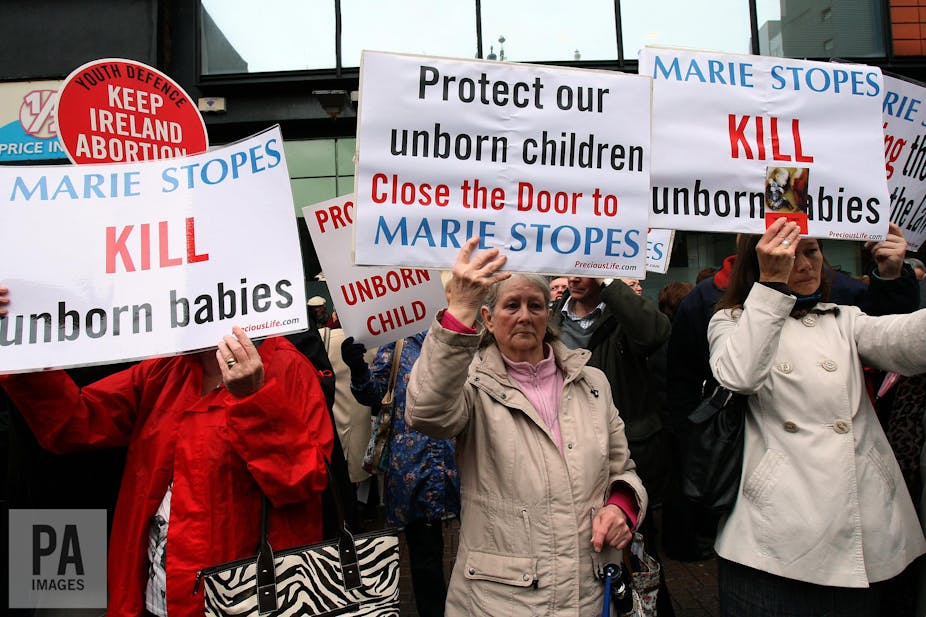Ealing council in West London could soon set up a buffer zone to limit the harassment faced by patients of a local abortion clinic. The clinic is run by the reproductive health charity Marie Stopes, one of many abortion providers across the UK regularly targeted by anti-abortion protestors. In mid-January, councillors voted to launch a public consultation about the creation of a Public Space Protection Order, or buffer zone, around the clinic.
Common forms of anti-abortion protest include public prayer, hymns, and chanting. Protesters also distribute leaflets exaggerating the risks of abortion, display posters including images of aborted foetuses, strew plastic foetuses across walkways, and verbally harass patients and health professionals.
Labour MP for Ealing Central and Acton, Rupa Huq, has called for a 150m radial “buffer zone” around the clinic, within which all forms of anti-abortion protest would be outlawed. Councils in Birmingham, Manchester, and Portsmouth are considering similar measures.
In late 2017, the home secretary, Amber Rudd, called for a review of intimidation and harassment of patients outside abortion clinics nationwide in response to rising concerns. The review could result in widespread curbing of anti-abortion action around clinics in England and Wales, which would remove the need for piecemeal interventions by councils.
A right to protest?
Opponents of buffer zones around abortion clinics often cite the importance of freedom of speech and the right to protest. But while protest activity is a sign of democratic health, the right to protest is not boundless.
Consider an analogy: I am opposed to the existence of private education, and would like to see the private education sector abolished. However, loitering outside private schools attempting to rouse feelings of guilt or fear in children and their parents is morally problematic, even though I maintain that their choices are morally troubling. The most effective place to take those grievances is to those with the power to determine whether or not private schools exist: politicians, or the independent schools association.
Protest action is necessarily defiant and disruptive; its objective is to be difficult to ignore. It is distinguished from harassment by its focus on influential individuals and institutions, whose power renders them reasonably invulnerable to intimidation, and makes them good strategic targets for demanding change. Alternatively, protests may have a more nebulous target: a march or a stall which is designed to raise awareness within a community, or generate press coverage, but which has no specific group in mind.
The staple tactics of anti-abortion activism fit neither of these models. Their target is specific: they seek interactions with individual pregnant patients or health professionals. In December, MPs on the home affairs committee heard how patients attending clinics had been referred to as “mum,” and chided by protestors that they would die of cancer, while clinic staff had been called “murderers”. In the US, several abortion providers have been murdered by activists.
Abortion stigma is still widespread in the UK. Combined with the inevitable distress of an unwanted pregnancy, this makes abortion patients vulnerable. Intimidating them and their caregivers is not protest, it’s bullying.
Anti-abortion protests outside clinics change nothing but the emotional state of the targeted individual. There is no evidence that they have any appreciable effect on the decisions of patients. Researchers in the US have shown that while women seeking abortions find the presence of protesters upsetting, they do not harbour long-term feelings of guilt regarding their abortions. Making abortions harder to access does not reduce their incidence – it merely increases the number of unsafe abortions.
If they’d like to see reform, anti-choice protestors should focus their efforts on lobbying those who hold power: the government, medical professional bodies or the offices – not clinics – of major abortion providers.
Protecting patients
All patients ought to be able to access medical treatment without intimidation, and with their confidentiality upheld. Without these guarantees, healthcare delivery would be severely undermined. In England, Scotland, and Wales, an abortion is a legal medical procedure, signed off by two doctors who are required to consider the individual context of the pregnancy.
Anti-abortion protestors harass patients attending medical appointments, hoping that they can summon sufficient guilt and repulsion to deter patients from seeking treatments that they and their doctors believe to be necessary. There are repeated reports of women being filmed entering or leaving clinics. This is a patent violation of confidentiality, and has been cited by patients as the primary reason why they oppose the presence of anti-abortion protestors outside facilities.
The tactics of anti-abortion activists should not be classified as protest – rather they are intent on capitalising on vulnerability. It may be that anti-abortion protestors recognise their poor odds in lobbying a government, the majority of which is pro-choice, elected to represent a public that is majority pro-choice, served by doctors who are also overwhelmingly pro-choice.
If buffer zones are introduced, they will not affect anti-abortion activists’ right to protest. They remain welcome to take their fight to Westminster, the Medical Royal Colleges, or the General Medical Council. Their platforms on radio stations and in newspapers are not under threat, and they will continue to be supported by influential religious lobby groups. Buffer zones around abortion clinics would remove rights they never had to start with: to intimidate patients, and to treat women as incapable of making decisions about their own bodies.

